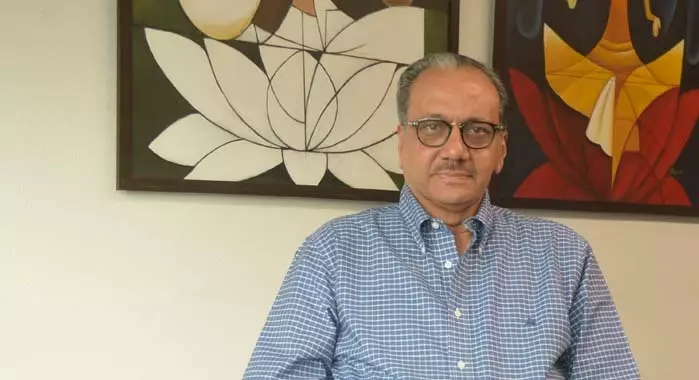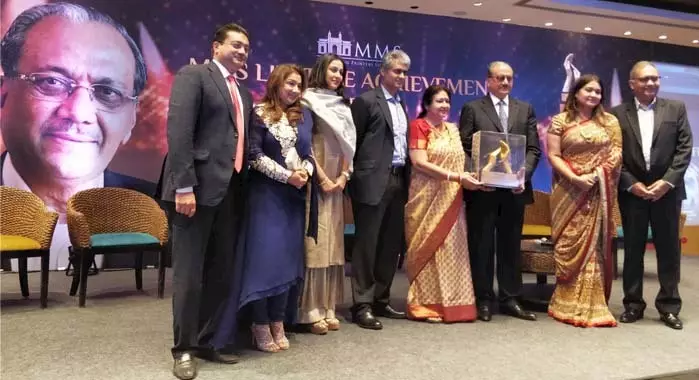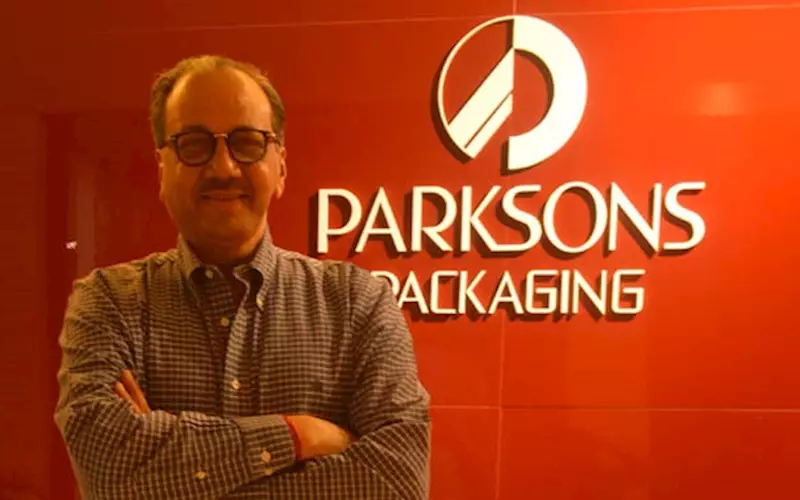Kejriwal: “Be respectful about debt-equity and have an appetite for risk”
Ramesh Kejriwal of Parksons Packaging is known for his sustained commitment and outstanding performance within the printing industry over a period of many years. In a tête-à-tête on the occasion of the Lifetime Achievement Award which was bestowed on him during a glittering ceremony at the Sahara Star on 24 February, Kejriwal shares his print journey of more than 45 years and vision for the firm
26 Feb 2018 | By PrintWeek India
If we can rewind a little, can you tell us about family background and your memories of childhood?
I think every human being of what he is today is largely based on his childhood memories and the learning that one has during one’s formative years. I would say I learned honesty from my father and simplicity from my mother. This has been true for me too. In our family, the ethos of being honest and hard-working was very strong and the same has been passed onto me. And I was good in my studies too and have never stood second in any exam till SSC. This was also because if the fact that my father had a big influence on me regarding education and constantly stressed its importance. The other influence was the home tutor whom I fondly remember as Gopal Sirji, who home-taught me and gained a lot of knowledge from him.
On the business front?
I will say I learned a great deal from my elder brother who had a very strong commercial sense and business mind. He had the ability to grasp numbers and balance sheets in a jiffy. Being with him taught me to be respectful about debt-equity and to have an appetite for risk.
What is it that makes the Marwari community prosper and keeps it ticking?
One of the important factors is honesty along with a commitment to deliver a job. If you are committed and honest in your dealings with your suppliers, customers and employers then you will succeed. These are some of the strong traits that you can observe in the Marwari community. Also, having come from tough circumstances from the region of Shekawat, the risk-taking appetite of this community is very high.
At the same time, in your journey, we have observed that you have been doing a lot of philanthropy-related work like building a school and hospital. How do you devote time to these activities and what has been the thought process?
I will say it has got to do more with my genes and hereditary and runs in the culture of the family. My grandfather and father had both built a school in our village during early days. Hence whenever an opportunity came up I got involved in these activities. When I reached the age of 60, I felt to give back to the society and get personally involve myself. Starting the vocational ITI in our village which is in Jhunjunu district in Rajasthan was close to my heart, as there was a need for it. Today I can confidently say that the infrastructure, buildings and the set up of the ITI have been one of the best in Rajasthan and can accommodate 400 students in a year. And I am proud to say that the institute has been successful since its launch in 2013.
It has been a long journey for you since your GIPT days in 1972?
I remember I started my journey as a printer in 1972 when I completed my graduation from GIPT (Government Institute of Printing Technology) in Mumbai. It has been a long journey of 45 years since. I clearly remember the day when two of our key personnel handling our day to day business in then Parksons Printers parted ways in 1978, the responsibility of managing our day to day business was entrusted on me. As most of you know, playing cards is a branded product and it’s not a service. But the quality required for manufacturing the printing side of the cards is very critical. All the 52 cards in a pack have to look identical; if even one card is not similar then it is not acceptable. So the quality culture was imbibed from the beginning.
Trivia about RBK
Spends time with the family and loves cards especially bridge
Is a fan of Bollywood movies. Last movie seen, Tiger Zinda Hain
Consumes business newspapers Business Standard and Economic Times, daily
Is super vigilant and passionate about grasping new technologies, and confabulating with people from other industries
Has a sense instinct of the techno-commercial part of business
Revels in his daily walk
How did the transition from playing card business to commercial printing business happen?
After ten years in the business, I learnt the commercial, market and financial aspects of the print business. I realised playing cards would not be a great business model for future. A lot of users will shift from playing cards to computers. That was the time, we decided to foray into commercial printing in the 1980s. It was a big challenge for us. Since in playing cards, we had to focus on production and selling the product. Whereas in commercial printing, we had to sell first and then manufacture. I remember the days, where I used to sit in advertising agencies’ office for hours together to get new orders. That was the time I realised that we had to do something different to grow. We invested in the first Heidelberg four-colour machine in 1986, and the first job printed was a poster for TVS. And when I saw the colour output, I knew this was a game changer. In 1987 we participated for the first time in the national print award in Hyderabad and bagged the maximum number of awards. By 1990, we had established ourselves as a commercial print firm, in addition to the playing card business, which was still the bread and butter.
You entered packaging in 1993. What made to think packaging as a business will be a good one to invest?
In 1991, commercial printing was doing good and I thought but what next. Around that period, we could see the demand for quality packaging amongst the multinationals and big brands. I remember being at the Unilever’s office, as we were catering to few commercial jobs there. The purchasing guy was grumbling over the inability of his supplier to print the specific toothpaste red. It was then I realised that if one of the largest buyers in India was finding it difficult then there was definitely a scope for us to cater to this need. We began our packaging journey in 1994 from commercial printing. Before investing in packaging, we did an in-depth study of the market. We asked Arthur Andersen and Indian Market Research Bureau (IMRB) to carry out a survey to understand its potential. It's only when they gave us a positive feedback, it reinforced our belief. It was in 1996 we underwent restructuring and started a separate company, Parksons Packaging.
Again, you were the first packaging converter to raise capital from the market…
When we started in 1996, we decided to invest Rs five-crore for our packaging business and went in for second-hand printing and post-press machines. This is the year we moved to Daman. Within a year I realised that the business had huge potential and we would not be able to sustain with second-hand machines. We finally marched on and in 2001 invested in a brand new Heidelberg six-colour machine with coater and another state of the art equipment.
By 2006, we were saturated at Daman and wanted to expand. To set-up a new greenfield packaging factory required investments worth Rs 50-60 crore. Being a conservative investor, I was looking for options for investments, without too much debt. The game changer for taking Parksons Packaging to the next level was when private equity player ChrysCapital India picked up stake in Parksons in 2006 and brought in Rs 50-crore capital. That’s how we set up the Chakan plant in Pune.
In 1987 BMPA had organised Pamex and you with Arun Mehta and Ashok Nerkar had played an important role in making the show a success. What is your opinion about print associations and their role in this industry?
I feel association is a must in any industry. Otherwise, how will the industry's issues be addressed? How will we make government representations?
A while ago, you had also shared a mantra about how much of a risk appetite should on take. How have you arrived at that?
It is very important to watch your capex to turnover ratio and it should remain the same for that particular industry. A firm should maintain a debt/equity ratio of about 1:1. As an organisation, we strive to be less than one which is a healthy way to do business.
Has there been a tendency in our industry to over-commit in terms of risk appetite our industry?
It is becoming increasingly difficult to invest in a packaging business due to high capital investments and lower margins. Plus looking at the demands from various MNC, like social audit etc, one not only has to invest in brand new machineries but also in systems and processes which is requires a steep investment. It’s tough for a Rs 50-crore company to grow to a Rs 100-crore company considering the margins involved.
2017 was a tough year, in spite of this Parksons Packaging has grown...
It has definitely been a tough year with two major disruptions: demonetisation and GST. The two factors have definitely impacted our customers and us and will reflect on our profitability.
What is the message that you would like to give fellow printers who want to enter packaging?
One has to consider two important aspects which are inventory and variable size of sheets. In the paper and paperboard packaging, you don’t have a standardised paper format of 23x30-inch or 23x40-inch, the art paper 130 and 140gsm or a map litho. You have various grammage and multiple sizes. Here, you cannot afford to waste any part of the paperboard. Which is why you must opt for a special size.

High inventory and WIP of material is something one has to look at.
Yes, if you are shifting from converting 20-30 tonnes of paper to a minimum of 100 tonnes to - upwards of 1000 tonnes. This means, lots of space leading to higher finance and infrastructure cost. In packaging, after you print, you cannot convert immediately. The first and foremost is the value addition which could be coating or foil stamping etc. We call it Work in Progress (WIP). For this, you require a lot of space, so space has to be planned properly which again entails large investment.
What about holding stocks? How does it work?
Again on the inventory side, the packaging end-customer asks you to hold the stocks. He puts an order and says the sales are sluggish so you are asked to hold the stock. In India, the problem is, customers do not pay for stock storage, and the packaging converter has to bear the cost of the stock.
Also, what is your view about the cost of marketing today? How much of this forms a large part of the ecosystem?
Having a strong marketing team is very crucial in packaging. They play an important role in getting the huge volumes and continued business, it's all about the services on offer. Having said that, the cost of marketing is a lot. At Parksons, we are converting about 6,000 metric tonnes every month. We have almost 60 people in marketing. We convert almost 70,000 tonnes of paperboard every year. We have a huge marketing which is costing huge to us. Also, as packaging is constantly evolving the marketing team has to be on the field and be agile in spotting new businesses. All this comes at a cost.

Ramesh Kejriwal conferred with a Lifetime Achievement award by the MMS on Printer's Day
How do you make sure that the marketing team spots new opportunities?
At Parksons we have not hired a marketing person directly from the market, we have always focussed on training the marketing persons from within our organisation. 80% of our marketing team are from the non-packaging background. There are two aspects to it, one is that they come with a fresh set of minds and the second is loyalty towards the company. We have employees who are with us for 10-15 years. We now have a leadership team, where we brainstorm and set strategy for conducting various HR and training programme.
What about the development cost involved in packaging?
For the established customers, we collaborate and work towards creating a new product. There is a huge development cost involved. The customer will give you an artwork, and you have to proof it and provide dummies, create a prototype and help produce the final product. In India, customers don’t pay for development cost. The only way to recover your development cost is adding it, to your final cost or having a larger customer base product. One has to be ready for development and absorb the development cost into your cost structure. We also have patented few packaging design too.
What is happening on the standards and certification front?
I feel the converters are doing much more than brands these days. Like adapting food-friendly inks etc, we try to learn every day and pass on the message to our customers. A lot of multinationals and food and pharma brands require huge social accountability and other regularity compliances. One has to be free from child labour and pay minimum wages and adhere to all the statutory compliances on the labour side. If you wish to stay within the technical standards and certifications, you must undertake regular maintenance and maintain not just your pre-press kit but also your proofing equipment and presses and post-press kit to a high standard. It's a question of inculcating a habit in your team and ensuring you are strict about this.
One innovation at Parksons which was a defining moment?
The turning point was to be the first packaging converter to go the private equity way and was defining moment for business per se. In technology front, it has to be UV and metallised printing. It was a game changer when we forayed into the metalised printing.
Is there a demarcation of the verticals that you cater to?
Three verticals which include: the first one is branded packaging which includes FMCG and food packaging, the second is healthcare packaging and finally liquid packaging. The growth will only come from giants like the Unilever and Nestle’s of the world.
You mentioned the target of Rs 5000-crore company, during the launch of your Sri City plant ...
Yes, it is something that I believe is achievable. We have analysed the market size, what is the bifurcation between organised and unorganised market, what is the growth rate the, the change expected in value chain among others. And if we manage the business well, then it is definitely achievable. We have a target to reach the Rs 1000-crore mark next year.
Siddharth Kejriwal's ode to his father

On behalf of Parksons Packaging and our family, I would like to thank MMS and the entire printing fraternity to have bestowed this honour to my father with this prestigious lifetime award for his contribution to the printing industry.
My brother and I are fortunate to have someone like him as our guide and mentor in life.
His dedication, commitment, passion and focus towards work is an inspiration and example for all of us in the organisation.
He continues to be very active and full of energy at work and plays a role of a visionary in our organisation. We all admire him for his astute business mind and the knack to see the future of our industry with great accuracy. He has always had a keen interest in the emerging trends in print technology and is able to assess the needs of our customers well before time and help adopt and adapt ourselves to any changing trends.
He has always followed simple principles in life which is to run the business with full honesty and integrity towards its employees, customers, suppliers and all stakeholders. It is the cornerstone of our company's culture and the main reason for our growth and success.
In his private life, he plays a role of the head of our family with complete ease and perfection. Living in a joint family, he is a perfect balance between being a disciplinarian and compassionate person. He is also involved in many social activities which include setting up an Industrial training institute in our village in Rajasthan with more than 350 full-time students.
Personally, I have learned life's greatest lessons from him at the backseat of the car during the half hour journey back and forth from home to work every day for the past 25 years of my life. These continue to be the most precious moments for me where I get an opportunity to discuss everything under this sun with him and it has taught and enriched me in my life and the way I conduct myself. For that one single selfish reason, I would never want him to retire from work.
He continues to be as passionate and forward-looking in his vision for the company even after spending 48 years in the print industry as his only passion and chosen career and as he enters his 68th birth year we wish him all the happiness, good health, and love on behalf of our family.
Thank you once again for this honour. We are indeed humbled.











 See All
See All